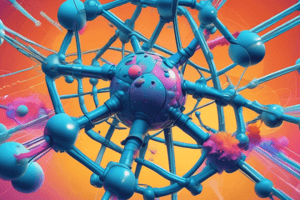Podcast
Questions and Answers
What is the structure of the atom?
What is the structure of the atom?
The atom consists of a nucleus made up of protons and neutrons, surrounded by electrons in various energy levels.
What are isotopes?
What are isotopes?
Isotopes are variants of a chemical element that have the same number of protons but a different number of neutrons.
What is emitted when an electron moves from a higher energy level to a lower energy level?
What is emitted when an electron moves from a higher energy level to a lower energy level?
- Visible light (correct)
- X-rays
- Gamma rays
- Infrared radiation
All isotopes of an element have the same chemical properties.
All isotopes of an element have the same chemical properties.
The main components of an atom are protons, neutrons, and __________.
The main components of an atom are protons, neutrons, and __________.
What do we call changes in the energy levels of electrons?
What do we call changes in the energy levels of electrons?
What is a redox reaction?
What is a redox reaction?
Flashcards are hidden until you start studying
Study Notes
Atomic Structure
- The structure of the atom is composed of a central nucleus containing protons and neutrons, surrounded by a cloud of negatively charged electrons.
- Protons are positively charged particles.
- Neutrons are neutral particles.
- Atomic mass is the sum of the protons and neutrons, represented by the symbol A.
- Atomic number is the number of protons in an atom, represented by the symbol Z.
Isotopes and Radioactivity
- Isotopes are atoms of the same element that have the same number of protons (atomic number) but a different number of neutrons.
- Radioactive isotopes are unstable isotopes that decay over time by emitting radiation.
- Common types of radioactive decay include alpha decay, beta decay, and gamma decay.
- Alpha decay involves the emission of an alpha particle (a helium nucleus with 2 protons and 2 neutrons).
- Beta decay involves the emission of a beta particle (an electron or a positron).
- Gamma decay involves the emission of gamma rays (high-energy electromagnetic radiation).
Energy Levels and Emission Spectra
- Electrons in an atom occupy specific energy levels or shells.
- Energy levels are quantized, meaning that electrons can only occupy specific discrete energy levels.
- When an electron transitions from a higher energy level to a lower energy level, a photon of light is emitted with an energy equal to the energy difference between the two levels.
- These emitted photons create a characteristic emission spectrum for each element.
Sub-shells and Atomic Orbitals
- Energy levels can be further divided into sub-shells, labeled as s, p, d, and f.
- Sub-shells contain atomic orbitals, which are regions in space where there is a high probability of finding an electron.
- The number of orbitals in each sub-shell is determined by the sub-shell's designation (e.g., s has 1 orbital, p has 3 orbitals).
- Each orbital can hold a maximum of two electrons with opposite spins (Pauli Exclusion Principle).
The Gas Laws
- Boyle's Law: The volume of a fixed mass of gas is inversely proportional to the pressure at a constant temperature.
- Charles's Law: The volume of a fixed mass of gas is directly proportional to the absolute temperature at constant pressure.
- Gay-Lussac's Law: The pressure of a fixed mass of gas is directly proportional to the absolute temperature at constant volume.
Kinetic Theory of Gases
- Gases are composed of particles (atoms or molecules) that are in constant random motion.
- The average kinetic energy of gas particles is proportional to the absolute temperature of the gas.
- Gas particles collide with each other and with the walls of their container.
- The pressure of a gas is due to the impact of the gas particles against the walls of their container.
Redox Reactions and Oxidation State
- Redox reactions are chemical reactions that involve the transfer of electrons.
- Oxidation is the loss of electrons.
- Reduction is the gain of electrons.
- The oxidation state of an atom represents its apparent charge in a compound.
- Rules include:
- The oxidation state of an element in its elemental form is zero.
- The oxidation state of monoatomic ions is equal to the charge of the ion.
- In compounds, halogens typically have an oxidation state of -1, oxygen is -2 (except in peroxides where it's -1), and hydrogen is +1.
Redox Equations
- Balancing redox equations involves making sure that the number of atoms of each element and the charges on both sides of the equation are equal.
- Half-equations can be used to represent the oxidation and reduction processes separately, making balancing easier.
- Half-equations are balanced by adding electrons to the side that needs them to balance the charges.
- The overall redox equation is obtained by adding the half-equations together and canceling out any common species.
Studying That Suits You
Use AI to generate personalized quizzes and flashcards to suit your learning preferences.




